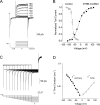Reversal of HCN channel voltage dependence via bridging of the S4-S5 linker and Post-S6
- PMID: 16908727
- PMCID: PMC2151568
- DOI: 10.1085/jgp.200609590
Reversal of HCN channel voltage dependence via bridging of the S4-S5 linker and Post-S6
Abstract
Voltage-gated ion channels possess charged domains that move in response to changes in transmembrane voltage. How this movement is transduced into gating of the channel pore is largely unknown. Here we show directly that two functionally important regions of the spHCN1 pacemaker channel, the S4-S5 linker and the C-linker, come into close proximity during gating. Cross-linking these regions with high-affinity metal bridges or disulfide bridges dramatically alters channel gating in the absence of cAMP; after modification the polarity of voltage dependence is reversed. Instead of being closed at positive voltage and activating with hyperpolarization, modified channels are closed at negative voltage and activate with depolarization. Mechanistically, this reversal of voltage dependence occurs as a result of selectively eliminating channel deactivation, while retaining an existing inactivation process. Bridging also alters channel activation by cAMP, showing that interaction of these two regions can also affect the efficacy of physiological ligands.
Figures






Similar articles
-
The S4-S5 linker couples voltage sensing and activation of pacemaker channels.Proc Natl Acad Sci U S A. 2001 Sep 25;98(20):11277-82. doi: 10.1073/pnas.201250598. Epub 2001 Sep 11. Proc Natl Acad Sci U S A. 2001. PMID: 11553787 Free PMC article.
-
Structural changes during HCN channel gating defined by high affinity metal bridges.J Gen Physiol. 2012 Sep;140(3):279-91. doi: 10.1085/jgp.201210838. J Gen Physiol. 2012. PMID: 22930802 Free PMC article.
-
Voltage-dependent gating of hyperpolarization-activated, cyclic nucleotide-gated pacemaker channels: molecular coupling between the S4-S5 and C-linkers.J Biol Chem. 2004 Apr 2;279(14):13859-65. doi: 10.1074/jbc.M313704200. Epub 2004 Jan 15. J Biol Chem. 2004. PMID: 14726518
-
Voltage sensing and activation gating of HCN pacemaker channels.Trends Cardiovasc Med. 2002 Jan;12(1):42-5. doi: 10.1016/s1050-1738(01)00141-4. Trends Cardiovasc Med. 2002. PMID: 11796244 Review.
-
Involvement of the S4-S5 linker and the C-linker domain regions to voltage-gating in plant Shaker channels: comparison with animal HCN and Kv channels.Plant Signal Behav. 2014;9(10):e972892. doi: 10.4161/15592316.2014.972892. Plant Signal Behav. 2014. PMID: 25482770 Free PMC article. Review.
Cited by
-
Functional and structural characterization of interactions between opposite subunits in HCN pacemaker channels.Commun Biol. 2022 May 9;5(1):430. doi: 10.1038/s42003-022-03360-6. Commun Biol. 2022. PMID: 35534535 Free PMC article.
-
Opposite Effects of the S4-S5 Linker and PIP(2) on Voltage-Gated Channel Function: KCNQ1/KCNE1 and Other Channels.Front Pharmacol. 2012 Jul 5;3:125. doi: 10.3389/fphar.2012.00125. eCollection 2012. Front Pharmacol. 2012. PMID: 22787448 Free PMC article.
-
cAMP control of HCN2 channel Mg2+ block reveals loose coupling between the cyclic nucleotide-gating ring and the pore.PLoS One. 2014 Jul 1;9(7):e101236. doi: 10.1371/journal.pone.0101236. eCollection 2014. PLoS One. 2014. PMID: 24983358 Free PMC article.
-
A novel mechanism for fine-tuning open-state stability in a voltage-gated potassium channel.Nat Commun. 2013;4:1784. doi: 10.1038/ncomms2761. Nat Commun. 2013. PMID: 23653196 Free PMC article.
-
Mechanism of electromechanical coupling in voltage-gated potassium channels.Front Pharmacol. 2012 Sep 12;3:166. doi: 10.3389/fphar.2012.00166. eCollection 2012. Front Pharmacol. 2012. PMID: 22988442 Free PMC article.
References
-
- Cordero-Morales, J.F., L.G. Cuello, and E. Perozo. 2006. Voltage-dependent gating at the KcsA selectivity filter. Nat. Struct. Mol. Biol. 13:319–322. - PubMed
-
- Decher, N., J. Chen, and M.C. Sanguinetti. 2004. Voltage-dependent gating of hyperpolarization-activated, cyclic nucleotide-gated pacemaker channels: molecular coupling between the S4-S5 and C-linkers. J. Biol. Chem. 279:13859–13865. - PubMed
-
- del Camino, D., and G. Yellen. 2001. Tight steric closure at the intracellular activation gate of a voltage-gated K+ channel. Neuron. 32:649–656. - PubMed
Publication types
MeSH terms
Substances
Grants and funding
LinkOut - more resources
Full Text Sources
Other Literature Sources
Miscellaneous

